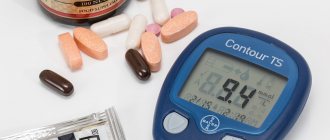Today, every eleventh adult on the planet has diabetes. This means that everyone may need information about the signs and treatment of diabetes - for themselves or for loved ones. Olga Anatolyevna Rozhdestvenskaya, chief physician, endocrinologist-nutritionist at the Polyclinic.ru MC, talks about the causes of type 2 diabetes mellitus, what is and is not possible with diabetes.
What is diabetes mellitus?
Diabetes mellitus (DM) is a group of metabolic diseases characterized by abnormally high levels of glucose (sugar) in the blood. Type 2 diabetes mellitus (T2DM) is the most common form of diabetes. With T2DM, our body doesn't use insulin correctly, a condition called insulin resistance. The pancreas makes an extra surge of insulin to compensate for the cells' insensitivity to insulin, but over time all protective mechanisms weaken and glucose metabolism gets out of control.
The danger of diabetes lies in its chronic, progressive course, which most often leads to the development of serious cardiovascular disasters, such as myocardial infarction, stroke and chronic heart failure.
Why get tested?
Any doctor can limit himself to simply listening to the patient and making a diagnosis based on his complaints. But will this be the right and correct decision, provided that he is obliged to cure the patient?
If you watched the TV series “House,” you probably remembered the main character’s phrase: “Everyone always lies!”
So in this case, you shouldn’t take my word for it - make sure!
To prescribe any treatment and write a prescription for medications, you need to be absolutely sure that you are right. Therefore, do not be surprised when doctors prescribe a whole range of different tests and diagnostic studies to their “wards”.
But this can only be attributed to the case when the diagnosis has not yet been made. If there are no doubts left, this does not mean that you won’t have to take anything else. Rather, on the contrary, everything is just beginning, because the “sweet disease” can quickly get out of control!
Testing for diabetes is always necessary to:
- Make the correct diagnosis
- Control the disease
- Monitor changes in diabetes compensation or decompensation
- Monitor the condition of internal organs, especially the pancreas and kidneys
- Self-monitor your blood glucose levels
- Select the correct dose of insulin for diabetes mellitus type 1 and type 2 in case of III degree of severity, when further treatment of the patient is no longer possible without insulin
- Monitor during pregnancy if you have existing or suspected gestational diabetes
- Prescribe the correct drug or non-drug treatment for a particular type of diabetes
- Monitor the treatment prescribed by the doctor and adjust it in time
- Determine the risk of developing long-term complications or the likelihood of a heart attack or stroke in advanced diabetes
Unfortunately, a cure for this disease has not yet been found and the main task of the doctor is, firstly, to teach the patient how to eat properly, and secondly, how to self-monitor blood sugar (for such purposes, every diabetic buys a glucometer and test -strips for it, which can be obtained free of charge as part of the state health care program), thirdly, constantly monitor your health in order to promptly prevent the development of long-term complications.
Quite a few questions have been asked on the topic of free medications, medicines, glucometers, test strips that a diabetic can receive and, unfortunately, it is often not easy to get help. It all comes down to the fact that citizens are completely unaware and unaware of their rights. We don’t know what “free treatment” is in Russia. And it’s really free with us. Not yet, but few people know about it... To help you:
Free medicines for diabetics
How to get disability for diabetes and what are the benefits
What signs of diabetes can you notice?
The main problem today is that type 2 diabetes remains undiagnosed for many years, since hyperglycemia (high blood sugar) develops gradually and is completely asymptomatic. People feel healthy and don’t complain about anything. You need to understand that the development of complications starts with the onset of diabetes.
Here are some symptoms that people with diabetes only occasionally experience:
- frequent urination
- thirst
- feeling hungry all the time, even if you've eaten recently
- extreme fatigue
- weakness
- blurred vision
- slow healing wounds
- numbness, tingling, pain in the lower extremities
Of course, with an increase in blood glucose levels, complaints become brighter and more characteristic of diabetes.
Blood test for magnesium for hypertension
If a person has high blood pressure, then, for example, in America, a blood test to determine the amount of magnesium in red blood cells is mandatory. This is not yet accepted in our country. This study should not be confused with an analysis of magnesium in plasma, which is not reliable, because even with a severe deficiency of magnesium, the results of the analysis will be normal.
Therefore, if a person has hypertension, but the kidneys are functioning normally, then you just need to start taking Magne-B6 in large doses and after three weeks evaluate whether your health has improved.
Magne-B6 is recommended for use by almost all people (80-90%). These blood sugar lowering tablets have the following effects:
- reduce blood pressure;
- help improve the condition of arrhythmia, tachycardia and other cardiac problems;
- increase tissue sensitivity to insulin;
- improve sleep, calm, eliminate irritability;
- regulate the functioning of the digestive tract;
- alleviate the condition of women with premenstrual syndrome.
Source: https://diabethelp.org/sdaem/analiz-na-diabet-2.html
What are the causes of type 2 diabetes?
The causes of diabetes mellitus are a combination of congenital and acquired factors. The famous scientist Robertson wrote that the main cause of diabetes is the personal genome of a person, which, like a loaded gun, can contain genes that are ready to fire at any moment (start the development of the disease) under the influence of environmental factors.
The risk of developing diabetes increases with age, obesity and a sedentary lifestyle. If immediate relatives have diabetes, then the risk increases from 2 to 6 times. It should be noted that newborns who were born weighing up to 2.5 kg and children raised on artificial feeding will also be at risk of developing diabetes.
Women are more likely to suffer from diabetes. Additional risk factors include gestational diabetes during pregnancy and newborns weighing 4 kg or more.
Blood test: information, rules, interpretation
Sugar testing is not only a diagnostic measure to establish diabetes mellitus, but also prevention. Doctors recommend that all people undergo this test at least once a year in order to detect possible pathology in time.
After the age of forty, you need to undergo several tests a year, since people in this age group have a significantly increased risk of developing type 2 diabetes. Those people who are at risk need to be tested 4-5 times a year.
A blood test is one of the main methods that allows one to suspect the development of diabetes, as well as some other pathologies associated with endocrine pathological disorders in the human body.
To avoid obtaining a false result, the patient must adhere to certain rules:
- Two days before the study, it is strictly forbidden to drink alcoholic beverages, even in small dosages.
- 10 hours before blood sampling, it is not recommended to eat any food, and you should not drink liquids (except water).
- It is not recommended to brush your teeth or chew gum in the morning, as they contain a certain amount of sugar, which can affect the correctness of the diagnostic test.
You can donate blood at any paid clinic, or at your medical institution at your place of residence. As a rule, the study is ready the next day. How is the received data decrypted?
It all depends on where the blood was taken from. If the blood was taken from a finger, then the norm is considered to be from 3.3 to 5.5 mmol/l. When taken from a vein, the values increase by 12%.
New information: Ketone bodies in urine: what it means and reasons
With values from 5.5 to 6.9 units, we can talk about a hyperglycemic state and suspicion of prediabetes. If the study showed a result of over 7.0 units, then the development of diabetes mellitus can be assumed.
In the latter case, it is recommended to repeat this analysis on different days, as well as implement other diagnostic methods. When sugar is less than 3.3 units, this indicates a hypoglycemic state, that is, blood sugar is below normal.
What treatment is there for diabetes?
There is still no “miracle pill” for diabetes. It is believed that if diabetes is detected at an early stage, or even better - at the prediabetes stage, the prognosis is much more favorable.
After a diagnosis of prediabetes or type 2 diabetes mellitus is made, the patient must immediately be prescribed glucose-lowering medications and given recommendations for lifestyle changes. After all, it has been scientifically proven that a balanced diet and physical activity in isolation are not able to completely and permanently compensate for diabetes. Therefore, it is so important to inform both patients and doctors of related specialties that the sooner adequate therapy is prescribed plus and changes in lifestyle occur, the better the prognosis will be.
A mandatory point in the treatment of diabetes is regular physical activity and strict control of blood pressure. Quitting smoking and reducing alcohol consumption are also necessary.
There is a misconception that simply going on a diet for diabetes will lower your blood sugar. Yes, normal blood sugar can be achieved with a diet, but not for long.
The question of the condition of the kidneys is vitally important.
What is the risk of new complications of the disease?
Is there a reduction in risk as a result of treatment interventions? The question of the likelihood of a heart attack or stroke is especially important. Diabetes mellitus requires that tests be taken regularly and their results will clearly show how good the effect is from following the regimen and maintaining a consistently low blood sugar concentration.
A large number of complications when diagnosed with diabetes mellitus can be prevented, as well as reversed. Very good results in diabetes therapy are achieved using a low-carbohydrate diet and other methods. They may even be significantly better than the usual “traditional” approach. Usually, the tests first improve, and then the patient notices an improvement in well-being.
What difficulties does a person with diabetes face?
Our patients experience difficulties only in conditions of chronic hyperglycemia (high blood sugar). They become more susceptible to both viral and infectious diseases. There is a predisposition to cancer. When injured, wounds heal more slowly. Well, the main difficulty for diabetics is impeccable compliance with all the doctor’s recommendations, since they hardly feel any complaints and consider themselves absolutely healthy.
Patients who are on insulin therapy or receiving combination glucose-lowering therapy are prone to hypoglycemia (low blood sugar), including loss of consciousness. This condition is extremely dangerous, as it can lead to a vascular accident. Hypoglycemia is especially severe in older patients. Of course, modern glucose-lowering drugs are safe and rarely lead to low sugar, but still, such conditions can only be prevented with the help of adequate self-monitoring and measuring blood glucose with a finger stick.
What are the possible complications of diabetes?
We keep telling our patients that along with the onset of diabetes mellitus, serious micro- and macrovascular complications occur. Under conditions of constantly elevated blood glucose or large fluctuations in its indicators, a cascade of pathological processes is triggered:
- microvascular complications: pathology of the vessels of the kidneys, retina;
- macrovascular complications: atherosclerosis of large vessels;
- changes in the liver;
- disruption of sex hormone production (rapid aging);
- osteoporosis;
- disruption of the intestinal microbiota and many other processes
How to control your condition with diabetes?
The main thing in diabetes mellitus is blood glucose control. The measurement is carried out on an empty stomach. In order to choose the right foods, we look at glucose before meals and 2 hours after meals. Those foods that give high glycemic fluctuations of more than 2 mmol/l must be excluded from the diet or their consumption reduced to a minimum.
Also, patients with diabetes need specialized medical examination: it should include the following blood and urine tests and consultations with related specialists:
- Glycated hemoglobin (HbA1C) - average blood sugar for 3 months (once every 3 months)
- General blood test (2 times a year)
- General urine test (2 times a year)
- Urine test for microalbuminuria (2 times a year)
- Biochemical blood test: protein, total cholesterol, HDL-C, LDL-C, triglycerides, bilirubin, AST, ALT, uric acid, urea, creatinine, potassium?, sodium?, GFR calculation, with reactive protein (at least once a year)
- Blood pressure monitoring (daily)
- ECG + ECG with stress tests
- Consultation with a cardiologist
- Consultation with an ophthalmologist
- Pediatrician consultation (diabetic foot office)
- Neurologist consultation
- Chest X-ray (once a year)
The list of examinations will increase as patients complain. Most often we add a blood test for sex hormones, especially in men, because... Due to decreased testosterone levels, their quality of life deteriorates.
It is important to motivate people with diabetes to lead an active, mobile lifestyle. After all, it is extremely difficult for our patients to start playing sports, since in conditions of glucose toxicity and insulin resistance, patients have a very strong reluctance to do anything. It’s not for nothing that they say: insulin is the hormone of laziness.
Serum ferritin
This indicator allows you to determine iron reserves in the body. Typically, this test is done if there is a suspicion that the patient has anemia due to iron deficiency. However, not all doctors know that excess iron can cause a decrease in tissue sensitivity to insulin, that is, insulin resistance develops.
In addition, serum ferritin leads to the destruction of vessel walls and increases the likelihood of a heart attack. Therefore, an analysis for this compound must be taken when conducting the entire complex of blood biochemistry.
If the results show that the body contains a lot of iron, then the person can become a blood donor. This measure allows you to treat insulin resistance and is a good prevention of heart attacks, as the body gets rid of excess iron.











